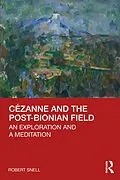By inviting a 'conversation' between them, this book offers a nuanced introduction both to Cézanne-the 'father of modern art'-and perhaps the most vital body of theory in contemporary psychoanalysis, 'post-Bionian field theory', as it has been evolving in Italy in the hands of Antonino Ferro, Giuseppe Civitarese, and others.
Cézanne and Bion, each insisting on his own truths, spearheaded quite new directions in painting and in psychoanalysis. Both point us towards a crucial insight: far from being isolated, self-contained 'subjects', we fundamentally exist only within a larger interpersonal 'field'. Cézanne's painting can give us a direct experience of this. For the Italian field analysts, building on Bion's work, the field is accessed through reverie, metaphor, and dream, which now come to occupy the heart of psychoanalysis. Here primitive 'proto-emotions' that link us all might be transformed-as Cézanne transformed his 'sensations'-into aesthetic form, into feelings-linked-to-thoughts that in turn enrich and expand the field.
The book draws on the words of artists (Cézanne himself, Mann), philosophers (Merleau-Ponty, Bergson), art historians and theorists (Clark, Smith, Shaw), as well as psychoanalysts (Bion, Ferro, Civitarese, and others), and it is the first to focus on one particular-and seminal-painter as a way of exploring this aesthetic and 'field' dimension in depth and detail. Aimed at psychoanalysts, psychotherapists, artists, art historians, and the general reader, it suggests how far art and contemporary psychoanalysis are mutually generative.
Autorentext
Robert Snell is the author of Théophile Gautier: A Romantic Critic of the Visual Arts (1982), Uncertainties, Mysteries, Doubts: Romanticism and the Analytic Attitude (2012), and Portraits of the Insane: Théodore Géricault and the Subject of Psychotherapy (2016). He is an analytic psychotherapist in private practice.
Inhalt
Introduction
1. Cézanne's journey: notes on an exhibition
2. The field idea
Genesis and evolution
Merleau-Ponty
The body of the visible
3. Conversations with Cézanne
Bion with Cézanne
Bion and Cézanne, the sublime and Bergson The proto-mental
From sensation to transformation: the Bionian and post-Bionian model
Negative Capability
Time, training, culture, experience, a home
Depth, space, volume
Colour
Sensation, intuition, reverie
a, ß
Caesura
The session (mountain) itself
'Characters'
Painter / analyst in the dream-field
Inter-relation, interpenetration, pluriverse
Evocative objects
O
The aesthetic and the contingent
4. The Art of the Impossible
References
Appendix
